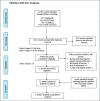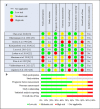Anaemia Is Associated with an Increased Risk of Fractures, a Systematic Review, and Meta-Analysis
- PMID: 35314584
- PMCID: PMC9808740
- DOI: 10.1159/000522591
Anaemia Is Associated with an Increased Risk of Fractures, a Systematic Review, and Meta-Analysis
Abstract
Background: Anaemia and osteoporotic fractures are both major health problems among older adults worldwide.
Objectives: Previous studies suggest that anaemia may be associated with elevated fracture risk among older adults; however, the exact relationship between them is unknown. We aimed to investigate the association between anaemia and fracture risk.
Methods: A comprehensive literature search was performed in four medical databases. We included articles that were published from inception to February 18, 2021. Odds ratios (ORs), hazard ratios (HRs) with 95% confidence intervals (CIs), and original raw incidences from studies comparing fracture rates in anaemic versus non-anaemic patients were extracted and pooled with the random-effects model. I2 test was used to assess heterogeneity. Risk of bias assessment was performed using the Quality of Prognostic Studies tool.
Prospero: CRD42021241109.
Results: A total of 13 studies were identified; 8 of them were included in the quantitative synthesis. Anaemia was found to be a risk factor for fracture compared to non-anaemia. Anaemia increased hip fracture risk in both older men (HR = 1.71; CI: 1.46-2.00, p< 0.001, I2 = 83.2%) and women (HR = 1.31; CI: 1.13-1.52, p< 0.001), but the fracture risk was more increased among men. There was also an increased chance of hip fracture in the presence of anaemia in populations, including both older men and women (OR = 1.64; CI: 1.35-2.01, p< 0.001, I2 = 61.1%). Anaemia was also associated with increased vertebral (HR = 1.21; CI: 1.04-1.40, p = 0.012) and all-type (HR = 1.49; CI: 1.19-1.86, p< 0.001) fracture risk in older men.
Conclusion: Our results suggest that there is a significant relationship between anaemia and fracture risk in older adults. This association is stronger among older men than women and differs in the different types of fractures.
Keywords: Anaemia; Bone; Fracture risk; Older adults.
© 2022 The Author(s). Published by S. Karger AG, Basel.
Conflict of interest statement
The authors have no conflicts of interest to declare.
Figures









Similar articles
-
Fracture prevention by screening for high fracture risk: a systematic review and meta-analysis.Osteoporos Int. 2020 Feb;31(2):251-257. doi: 10.1007/s00198-019-05226-w. Epub 2019 Dec 14. Osteoporos Int. 2020. PMID: 31838551 Free PMC article.
-
Long-term risk of subsequent major osteoporotic fracture and hip fracture in men and women: a population-based observational study with a 25-year follow-up.Osteoporos Int. 2021 Dec;32(12):2525-2532. doi: 10.1007/s00198-021-06028-9. Epub 2021 Jun 24. Osteoporos Int. 2021. PMID: 34165587
-
Sarcopenia combined with FRAX probabilities improves fracture risk prediction in older Chinese men.J Am Med Dir Assoc. 2014 Dec;15(12):918-23. doi: 10.1016/j.jamda.2014.07.011. Epub 2014 Sep 24. J Am Med Dir Assoc. 2014. PMID: 25262197
-
Grip strength in men and women aged 50-79 years is associated with non-vertebral osteoporotic fracture during 15 years follow-up: The Tromsø Study 1994-1995.Osteoporos Int. 2020 Jan;31(1):131-140. doi: 10.1007/s00198-019-05191-4. Epub 2019 Oct 25. Osteoporos Int. 2020. PMID: 31650188
-
Meta-analysis of hypertension and osteoporotic fracture risk in women and men.Osteoporos Int. 2017 Aug;28(8):2309-2318. doi: 10.1007/s00198-017-4050-z. Epub 2017 Apr 26. Osteoporos Int. 2017. PMID: 28447105
Cited by
-
Preoperative Anaemia Increases the Likelihood of 1-Year Mortality After Hip Fracture.Adv Orthop. 2025 Mar 29;2025:5526883. doi: 10.1155/aort/5526883. eCollection 2025. Adv Orthop. 2025. PMID: 40191446 Free PMC article.
-
Moderate to severe anemia at admission increases the risk of complications in patients over 60 years with hip fracture.BMC Geriatr. 2024 Sep 20;24(1):775. doi: 10.1186/s12877-024-05335-0. BMC Geriatr. 2024. PMID: 39304854 Free PMC article.
References
-
- Mathers CD, Stevens GA, Boerma T, White RA, Tobias MI. Causes of international increases in older age life expectancy. Lancet. 2015;385((9967)):540–548. - PubMed
-
- McLean E, Cogswell M, Egli I, Wojdyla D, de Benoist B. Worldwide prevalence of anaemia, WHO vitamin and mineral nutrition information system, 1993–2005. Public Health Nutr. 2009;12((4)):444–454. - PubMed
-
- Lanier JB, Park JJ, Callahan RC. Anemia in older adults. Am Fam Physician. 2018;98((7)):437–442. - PubMed
-
- Lane NE. Epidemiology, etiology, and diagnosis of osteoporosis. Am J Obstet Gynecol. 2006;194((2 Suppl)):S3–11. - PubMed
Publication types
MeSH terms
LinkOut - more resources
Full Text Sources
Medical

